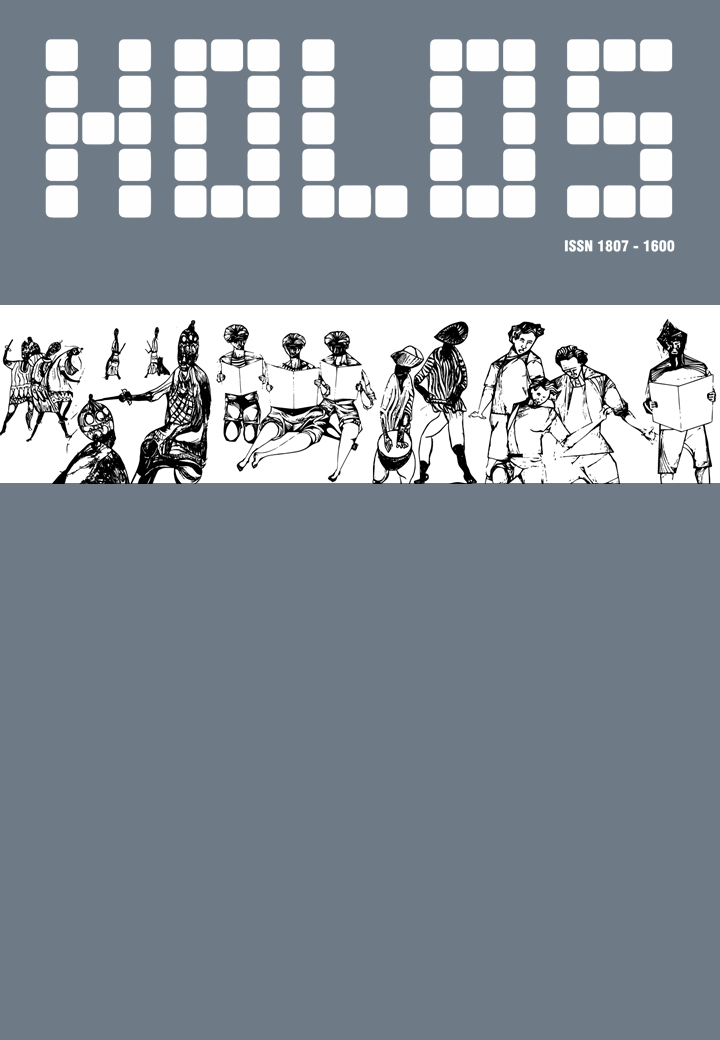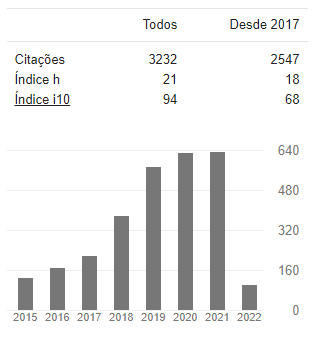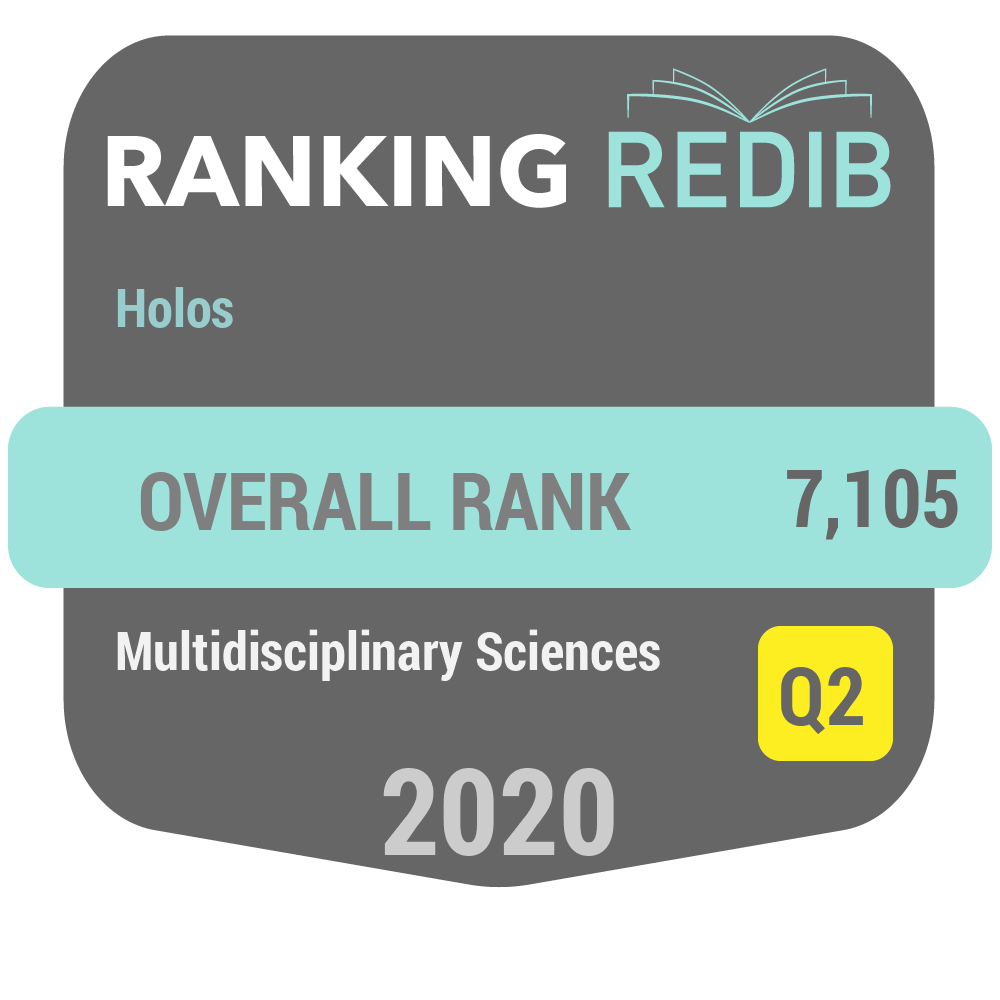La Expresión Corporal como forma de comunicación esencial
DOI:
https://doi.org/10.15628/holos.2019.8477Palavras-chave:
Comunicación no verbal, expresión corporal, semiología, lenguaje simbólico, educación artística.Resumo
La disciplina denominada Expresión Corporal comprende un campo multidisciplinar en el que confluye el terreno educativo y comunicativo, pero también el artístico y terapéutico. El acto de comunicar con el cuerpo supone un hecho indesligable en la ontogenia del individuo, hecho tradicionalmente estudiado en el ámbito académico por el campo de la comunicación no verbal. En este trabajo se realiza una propuesta para reformular el enfoque de investigación de la también denominada Técnica y Expresión de Movimiento, definiendo los orígenes artísticos de la misma y situándola como disciplina de características independientes respecto de la danza y la comunicación no verbal. De esta forma, se contemplan nuevas posibilidades en su estudio, conectando su origen artístico con sus potencialidades en el terreno comunicativo, educativo y socio-terapéutico.Downloads
Referências
Abe, N. (2017). Towards a sociology of movement: Application of Kinetography Laban to the study of collective phenomena in the Paris subway. Social Science Information, 56, (2), 174-197. https://doi.org/10.1177/0539018417694775.
Angotti, V. L., & Herr, J. L. (1974). Etienne Decroux and the Advent of Modern Mime. Theatre Survey, 15(1), 1-17. https://doi.org/10.1017/S0040557400006141.
Artaud, A. (1986). El teatro y su doble. Barcelona: Edhasa.
Aslan, O. (1979). El actor en el siglo XX. Evolución de la técnica. Problema ético. Barcelona: Gustavo Gili.
Barba, E. (2003). Grandfathers, Orphans, and the Family Saga of European Theatre. New Theatre Quarterly, 19(2), 108-117. https://doi.org/ 10.1017/S0266464X03000034.
Barba, E. & Savarese, N. (1988). Anatomía del actor. Diccionario de antropología teatral. México: Grupo Editorial Gaceta/International School Theatre Anthropology.
Bode, R. (2014). Rhythm and its Importance for Education. Body and Society, 20, 51-74. https://doi.org/10.1177/1357034X14546670.
Cohen, R. (2013). Acting Power. London and New York: Routledge. Taylor & Francis Group.
Davis, F. (1998). La comunicación no verbal. Madrid: Alianza Editorial.
Decroux, È. (2000). Palabras sobre el mimo. México: El Milagro.
Doat, J. (1976). La expresión corporal en el comediante. Buenos Aires: Eudeba.
Ekman, P. & Friesen, W. V. (1969). The repertoire of nonverbal behavior: categories, origins, usage and coding. Semiotica, 1, 49-98. https://doi.org/10.1515/semi.1969.1.1.49.
Espenak, L. (1989). Movement Diagnosis Tests and the Inherent Laws Governing Their Use in Treatment: An Aid in Detecting the Lifestyle. American Journal of Dance Therapy, 11 (2), 77-83. https://doi.org/10.1007/BF00843772.
Ferrari, H. (2015). El enfoque de la enseñanza del movimiento según el método Schinca. Acotaciones, 35, 115-149.http://www.resad.es/Acotaciones/index.php/ACT/article/view/40/100.
Finter, H. & Griffin, M. (1997). Antonin Artaud and the Impossible Theatre: The Legacy of the Theatre of Cruelty. The Drama Review, 41 (4), 15-40. https://doi.org/10.2307/1146659.
García, I., Pérez, R. & Calvo, A. (2013). Expresión corporal. Una práctica de intervención que permite encontrar un lenguaje propio mediante el estudio y la profundización del empleo del cuerpo. Retos, 23, 19-22. https://dialnet.unirioja.es/servlet/articulo?codigo=4135190.
Grotowski, J., Wiewiorowski T. K. & Morris, K. (1967). Towards the Poor Theatre. The Tulane Drama Review, 11 (3), 60-65. https://www.jstor.org/stable/1125118.
Knapp, M.L., Wiemann, J.M. & Daly, J. A. (1978). Nonverbal communication: issues and appraisal. Human Communication Research, 4 (3), 271-280. https://doi.org/10.1111/j.1468-2958.1978.tb00616.x
Kotz, S. A., Ravignani, A., & Fitch, W. T. (2018). The Evolution of Rhythm Processing. Trends in Cognitive Sciences, 22(10), 896-910. https://doi.org/10.1016/j.tics.2018.08.002
Laban, R. (1960). The mastery of movement. (2ªed.: London: Macdonald & Evans, 1980).
Laster, D. (2012). Embodied memory: Body-memory in the performance research of Jerzy Grotowski. New Theatre Quarterly, 28(3), 211-229. https://doi.org/10.1017/S0266464X12000413.
Lecoq, J. (2003). El cuerpo poético. Barcelona: Alba Editorial.
Lust, A. (1971). Étienne decroux and the French school of mime. Journal Quarterly Journal of Speech, 57 (3), 291-297. https://doi.org/10.1080/00335637109383071.
Odom, S. L. (2005). Delsartean Traces in Dalcroze Eurhythmics. Mime Journal, 23, 136-151. https://doi.org/10.5642/mimejournal.20052301.09.
Oida, Y. (1993). From an Actor Adrift. Asian Theatre Journal, 10 (2), 202-212. https://doi.org/10.2307/1124180.
Reca, M. (2017). Reconstructing the World of Survivors of Torture for Political Reasons through Dance/Movement Therapy. The Oxford Handbook of Dance and Wellbeing, online publication. https://doi.org/10.1093/oxfordhb/9780199949298.013.35.
Rothe, K. (2012). Economy of human movement: Performances of economic knowledge. Performance Research, 17(6), 32-39. https://doi.org/10.1080/13528165.2013.775756.
Ruiz Osante, B. (2008). El arte del actor en el siglo XX. Un recorrido teórico práctico por las vanguardias (Teoría y Práctica). Bilbao: Artezblai.
Sainsbury, P. (1964). Muscle responses: Muscle tension and expressive movement. Journal of Psychosomatic Research, 8 (3), 179–185. https://doi.org/10.1016/0022-3999(64)90038-8.
Santiago, P. (2004). Expresión Corporal y Comunicación: Teoría y Práctica de un Programa. Salamanca: Amarú.
Schinca, M. (2010). Expresión Corporal: Técnica y Expresión de Movimiento. Madrid: Wolters Kluwer.
Seitz, J. A. (2005). Dalcroze, the body, movement and musicality. Psychology of Music, 33(4), 419-435. https://doi.org/10.1177/0305735605056155.
Stern, D. (2010). The issue of vitality. Nordic Journal of Music Therapy,19 (2), 88–102. https://doi.org/10.1080/08098131.2010.497634.
Watson, I. (2013). The Odin actor: Embodied technology, memory, and the corporeal archive. Theatre, Dance and Performance Training, 4(3), 399-411. https://doi.org/10.1080/19443927.2013.824500.
Whitehead, C. (2017). An explanation and analysis of one principle of Meyerhold’s Biomechanics ? tormos. Theatre, Dance and Performance Training, 8(1), 89-102. https://doi.org/10.1080/19443927.2016.1214890.









































